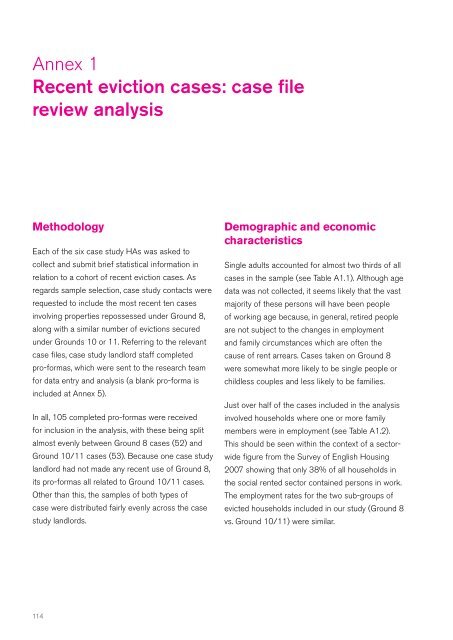Rent arrears management practices in the housing association sector
Rent arrears management practices in the housing association sector
Rent arrears management practices in the housing association sector
You also want an ePaper? Increase the reach of your titles
YUMPU automatically turns print PDFs into web optimized ePapers that Google loves.
Annex 1<br />
Recent eviction cases: case file<br />
review analysis<br />
Methodology<br />
Each of <strong>the</strong> six case study HAs was asked to<br />
collect and submit brief statistical <strong>in</strong>formation <strong>in</strong><br />
relation to a cohort of recent eviction cases . As<br />
regards sample selection, case study contacts were<br />
requested to <strong>in</strong>clude <strong>the</strong> most recent ten cases<br />
<strong>in</strong>volv<strong>in</strong>g properties repossessed under Ground 8,<br />
along with a similar number of evictions secured<br />
under Grounds 10 or 11 . Referr<strong>in</strong>g to <strong>the</strong> relevant<br />
case files, case study landlord staff completed<br />
pro-formas, which were sent to <strong>the</strong> research team<br />
for data entry and analysis (a blank pro-forma is<br />
<strong>in</strong>cluded at Annex 5) .<br />
In all, 105 completed pro-formas were received<br />
for <strong>in</strong>clusion <strong>in</strong> <strong>the</strong> analysis, with <strong>the</strong>se be<strong>in</strong>g split<br />
almost evenly between Ground 8 cases (52) and<br />
Ground 10/11 cases (53) . Because one case study<br />
landlord had not made any recent use of Ground 8,<br />
its pro-formas all related to Ground 10/11 cases .<br />
O<strong>the</strong>r than this, <strong>the</strong> samples of both types of<br />
case were distributed fairly evenly across <strong>the</strong> case<br />
study landlords .<br />
114<br />
Demographic and economic<br />
characteristics<br />
S<strong>in</strong>gle adults accounted for almost two thirds of all<br />
cases <strong>in</strong> <strong>the</strong> sample (see Table A1 .1) . Although age<br />
data was not collected, it seems likely that <strong>the</strong> vast<br />
majority of <strong>the</strong>se persons will have been people<br />
of work<strong>in</strong>g age because, <strong>in</strong> general, retired people<br />
are not subject to <strong>the</strong> changes <strong>in</strong> employment<br />
and family circumstances which are often <strong>the</strong><br />
cause of rent <strong>arrears</strong> . Cases taken on Ground 8<br />
were somewhat more likely to be s<strong>in</strong>gle people or<br />
childless couples and less likely to be families .<br />
Just over half of <strong>the</strong> cases <strong>in</strong>cluded <strong>in</strong> <strong>the</strong> analysis<br />
<strong>in</strong>volved households where one or more family<br />
members were <strong>in</strong> employment (see Table A1 .2) .<br />
This should be seen with<strong>in</strong> <strong>the</strong> context of a <strong>sector</strong>wide<br />
figure from <strong>the</strong> Survey of English Hous<strong>in</strong>g<br />
2007 show<strong>in</strong>g that only 38% of all households <strong>in</strong><br />
<strong>the</strong> social rented <strong>sector</strong> conta<strong>in</strong>ed persons <strong>in</strong> work .<br />
The employment rates for <strong>the</strong> two sub-groups of<br />
evicted households <strong>in</strong>cluded <strong>in</strong> our study (Ground 8<br />
vs . Ground 10/11) were similar .




